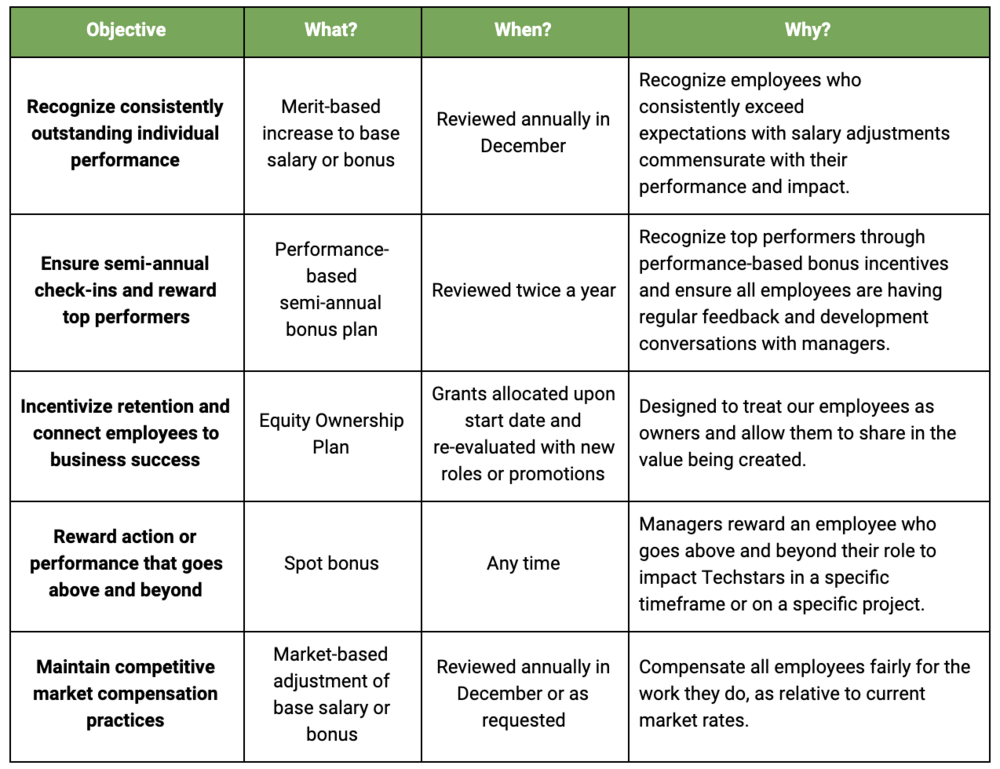Building a Compensation Philosophy to Reward Top Talent
Aug 28, 2019

6-min read
By Sabrina Kelly, Vice President of Talent at Techstars
All employees are motivated differently, and you can’t assume that what motivates one is the same thing that motivates another. That’s what makes structuring incentives so challenging - whether it’s the desire for a higher title to display recognition or the feeling of ownership that comes from equity. Sabrina Kelly, Vice President of Talent at Techstars with years of expertise recruiting top technical talent for large scale-ups, helps you understand why setting a compensation philosophy allows for transparency and increased trust with your employees. She looks at different types of compensation to motivate, reward and retain your best employees.
Compensation conversations are hard, almost always, even the good ones can be stressful. As a founder, figuring out how to set and navigate compensation early on is critical to the ongoing success of your business and motivation of your employees. One of the most common mistakes we see early on is founders setting compensation for early employees pretty subjectively. It might be based on gut instinct of what is fair for the position, what runway you have available, or some combination of that plus whatever the candidate asks for. While that approach might not cause any major headaches with your first few employees, it will undoubtedly catch up with you as the team starts to build.
One piece of advice we give to our companies early on is to set a compensation philosophy so that you have a guiding light for these decisions from the beginning. Setting a compensation philosophy doesn’t mean that you lose all flexibility in how you structure compensation (that can actually be built-in), it simply serves as a framework for those decisions. It’s a clear and consistent answer to the “why?” question that comes up in every compensation discussion. When done well, a compensation philosophy can set the stage for building a more transparent culture and building trust with employees.
When done well, a compensation philosophy can set the stage for building a more transparent culture and building trust with employees.
So, granted you’re convinced on its value, where do you start?
Our advice would be to think about your business and ask yourself a few important questions to begin formulating some plan objectives:
Have you established company values? If so, what are they and how might you encourage those values through your incentive structure?
How do you want to motivate your employees and how many levers do you need to do so effectively? Is base salary and equity enough or do you think regular bonus targets are needed to drive behaviors tied to the goals and pace of your business?
How do you want to recognize and reward top performers? Do you want to have components like variable compensation, spot bonuses or equity top-ups that support that recognition?
Are there other unique benefits (wellness, sabbaticals, flexible work hours, etc.) of working for your company that you can emphasize as part of the philosophy?
Do you plan to compensate revenue generating employees differently than other employees? If so, have you thought about your philosophy around commission and variable compensation?
Do you have employees in multiple geographies and if so, how will you factor in cost-of-living when determining compensation?
Will all employees receive equity or does that kick in at a certain level?
The outcome of these questions should be the following:
A guiding philosophy that aligns with the values of your business and that you feel confident you could commit to with consistency for new and existing employees.
The “why” that helps you attract, retain and motivate your team. Below is an example:
At Techstars, we have a pay for performance philosophy on compensation. We aim to pay competitively in all markets we employ and consider factors like impact and performance when evaluating compensation for each employee. There are many factors that impact compensation globally, and we use benchmarking tools and processes to consider that data, along with subjective factors (ties to values, performance, impact) in our decision making.
Beyond cash compensation and financial incentives, it’s our goal that all employees are motivated and inspired by the mission that we’ve set out on to make a positive difference in the lives of entrepreneurs all over the world. We believe, through our mission, network and commitment to progress, that all Techstars employees can gain valuable skills, perspective and connections that will support their careers for years to come.
A list of your compensation elements and the outcomes you’re hoping to achieve with each. Below is a simple example:

How do you know it’s good? Picture yourself explaining it (or better yet, try it out):
To your top candidate for a current opening; does it help you close them on the job and give them confidence in the company?
To your entire employee base at your next meeting; does it help you retain employees by giving them a feeling of equity and transparency?
To your top performing sales exec; does it help you motivate them toward behaviors that drive the success of your business?
If the answer to all of those questions is yes, you probably have a great starting point for a philosophy that you can stand by as the company starts to scale. If any of the answers were no, take the time to examine what felt off and adjust those elements until it feels genuine and aligned.
Lastly, below are a few key pieces of advice we’d share in helping you to develop a strong philosophy as an early-stage founder.
Use benchmarks early and decide where you want to fall within them. At Techstars we partner with Advanced HR / OptionImpact to give our portfolio companies access to updated cash and equity benchmarks by funding stage, geography and revenue. Tap into the resources available to you in order to build consistency and equity in your pay practices early on.
When using benchmarks, decide where you stand for consistency. I tend to recommend aiming for total cash compensation to be between the 40th-60th percentile of market. Someone new in a position may be lower in the range, and someone experienced may come in higher. When benchmarking equity, for early employees you may want to target closer to 60th-75th percentile. Beth Scheer, from Homebrew has a great philosophy on the value of over-equitizing early employees that you can check out here.
Put a basic leveling framework in place. It will evolve over time to match the levels added as your company grows but it’s extremely difficult to benchmark compensation, especially equity, with any level of consistency without having some basic system of levels in place. Think: entry, mid, senior, dir, VP, C.
Decide what you’ll negotiate on and what you won’t. For areas you’ll negotiate, give yourself and your managers ranges to play within using levels.
Most importantly, don’t assume that compensation is the only driver to employee engagement. Instead, listen to them. When an employee comes to you with a compensation request, always listen actively and try to get to the root of where the request is coming from. Oftentimes the issue is much deeper than compensation and not one that a simple increase will solve. Don’t miss the opportunity to dig deeper in those conversations and understand what’s really going on.
About the Author

Sabrina Kelly
As Vice President of Talent, Sabrina leads the team that helps Techstars to maximize the value of our most important asset - our incredible network of people. Sabrina's career started with an early love for talent in the NYC startup scene recruiting top technical talent for companies like Spotify, IAC and Etsy, then gaining exposure to startup HR in the Boston market, before ultimately leading People Operations globally at Techstars for five years.
